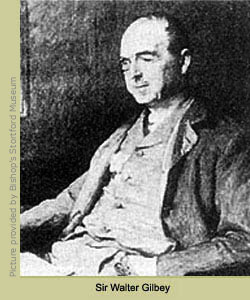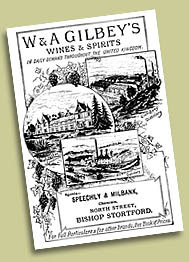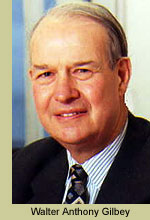|
 Walter Gilbey was a man who made the most of his life, becoming one of the most successful, influential and philanthropic men ever to emerge from Bishop’s Stortford. His aptitude for business at an early age and his benevolence towards the town in later years, even though he then lived at Elsenham, make the names Gilbey and Bishop’s Stortford synonymous. Walter Gilbey was a man who made the most of his life, becoming one of the most successful, influential and philanthropic men ever to emerge from Bishop’s Stortford. His aptitude for business at an early age and his benevolence towards the town in later years, even though he then lived at Elsenham, make the names Gilbey and Bishop’s Stortford synonymous.
He was born at No 11 Windhill, Bishop’s Stortford on 2 May 1831, the sixth child of Henry and Elizabeth Gilbey. His father was from Essex farming stock but at the start of the 19th century took to innkeeping in Stansted. After the Napoleonic wars and the severe economic depression that followed, he was forced to give up his position as landlord of the Bell inn at Stansted Road and moved to Bishop’s Stortford. Here he started a successful passenger stagecoach service to London, for the most part taking the reins himself, but with the imminent arrival of the railway his business ended in 1841. Forced to sell his home at Windhill he then returned to his former trade and became landlord of the Red Lion Inn at Hockerill. But his term there was short. He died the following year leaving a wife and seven children with very little material or financial wealth.
Walter was educated at Bishop's Stortford grammar school, but perhaps influenced by his father’s earlier success he also drove a coach at the start of his working life, combining this with a job as an apprentice to his cousin – a land surveyor. At the age of 19 the opportunity to pursue a more promising career beckoned at Westminster where he worked in a parliamentary agent’s office.
But by 1853 Russian expansion and their subsequent occupation of the Crimea, previously controlled by Turkey, led Britain and France to unite in war against the Russians and both Walter and his brother, Albert, volunteered for service as civilian clerks in the Army Pay Department. Still in his early twenties Walter served in Galipoli but spent most of his time working at a convalescent hospital on the Asiatic shores of the Dardanelles.
Both brothers returned safely to England in 1857 but having little idea of what to do with their lives, consulted their elder brother Henry, a prosperous wine merchant, who advised them that an opening existed for the import of wines from South Africa. At that time wine imported from countries other than Europe attracted less import duty.
With money loaned from Henry they took over a basement at 372 Oxford Street, London, and advertised in leading publications and the provincial press. The response was phenomenal and within months they had more than 20,000 customers on their books – including the novelist Charles Dickens whose framed cheques were later hung in the director’s luncheon room at Gilbey’s head office in Harlow.
At that time, Vintners i.e. innkeepers, hotels and wine merchants, supplied only the aristocracy with wine in cases of a dozen bottles – mainly because it was only they who were rich enough to buy it. But the Gilbey brothers broke the mould. They sold wine by the bottle to the general public, making Walter Gilbey, arguably, the man responsible for the democratisation of wine drinking.
To the Gilbey's disadvantage, in 1860 the Chancellor of the Exchequer, William Gladstone, equalized the duty on colonial and foreign wines but did permit the sale of liquor in so-called Off-licences i.e. establishments other than wine merchants. This the Gilbey brothers took full advantage of and quickly appointed agents all over the country, selling their wines in grocers’ shops and even chemists (including, locally, Speechly & Milbank's in North Street). By the year's end they had become the third largest importers of wine in Britain.
Such expansion of the business led to the need for larger premises. They increased their holdings by moving, first to the Pantheon in Oxford Street – a former concert hall and opera house – and by 1869 to new offices and extensive warehouses in Camden Town where they also built a gin distillery. These buildings still exists at Camden Lock but have now been converted into private apartments. The site of the Pantheon in Oxford Street is currently occupied by Marks & Spencer’s store. As the business continued to grow they then branched out into whisky, taking over two distilleries in Scotland in the 1880s, and in 1895 began to market their own gin – ‘Gilbey’s Gin’ soon becoming a household name.
In 1858, the year after his return from the Crimean War, Walter had married Ellen Parish, the fourth daughter of the landlord of the White Horse Inn at North Street, and soon after moved to London so that Walter could be close to his business. They stayed there for seven years and in the course of their marriage raised a family of eight children – four boys and four girls.
With his business and prosperity going from strength to strength, Walter took out a lease on Hargrave House, Stansted, in 1864 then, soon after, turned his attention to other pursuits in the world of business and leisure.
 In 1868 he bought the title of Lord of the Manor of Bishop's Stortford from the Ecclesiastical Commissioners, which included the manorial rights and approximately 950 acres of land. When the lease expired on Hargrave House in 1874 he moved to Brighton but returned a few years later to take out a lease on Elsenham Hall – a large, elegant Georgian mansion near Stansted. In 1868 he bought the title of Lord of the Manor of Bishop's Stortford from the Ecclesiastical Commissioners, which included the manorial rights and approximately 950 acres of land. When the lease expired on Hargrave House in 1874 he moved to Brighton but returned a few years later to take out a lease on Elsenham Hall – a large, elegant Georgian mansion near Stansted.
He was a sportsman as well as a lover of horses and during the 1880s was president of at least three equine societies including the Shire Horse Society (of which he was one of the founders), and the Hunters Improvement Society. He also co-founded the London Harness Horse Parade, became a governor of the Royal Veterinary College, and in 1896 was made president of the Royal Agricultural Society. His extensive knowledge of horses led him to write many books on the subject.
Never one to sit on his laurels, Walter entered into another venture in 1889 by starting his own fruit growing and preserving business on his Elsenham estate: his motive being to prove that fruit could be successfully grown in Essex as well as in Kent and other southern counties. The Jam factory at Elsenham began operations in 1893, the same year he received a baronetcy for his services to horse breeding and agriculture. He was now Sir Walter Gilbey.
In 1895 he gave land in Rye Street on which the town’s first hospital was built, and on part of the 950 acres acquired from the Ecclesiastical Commissioners, created Hockerill Park Estate and the town’s golf course.
A regular visitor to Elsenham Hall and to his stables near Elsenham Station was the Prince of Wales, later Edward VII, with whom Walter formed a close friendship. After the death of his beloved wife in 1896 he built, in her memory, a gilded dome over a well in Elsenham and paid for construction of almshouses in South Street, Bishop’s Stortford. These he named King’s Cottages in recognition of his association with royalty. He also bought the Stort Navigation in 1898 in an effort to keep it open for the benefit of the town, but finally had to sell it in 1905 at great financial loss to himself.
By 1907 his estate at Elsenham was producing all kinds of fruit, although the fruit and jam business was not profitable at that time. He later experimented with the growing of lavender and mint and continued to write books on horses, carriages, hounds and even poultry, as well as writing innumerable newspaper and magazine articles. He also became a justice of the peace and Deputy Lieutenant of Essex.
Part of his manorial lands purchased in 1868 included the old town mill in Bridge Street. This was demolished in 1895, and in 1911 he gave the land on which it had stood to the town. When he died on 12 November 1914, aged 83, he was buried alongside his wife in New Cemetery, Apton Road.
His eldest son, Walter Henry Gilbey, inherited the baronetcy at the age of 55 and went on to become chairman of W & A Gilbey Ltd. The Company then extended their interests, becoming responsible for such household names as Hennesey brandy, Smirnoff vodka and Croft port and sherry, as well as the eponymous Gilbey’s gin. However, as a result of increased taxes and out-dated work practices, the company fell into dire financial straits and take-over attempts were made. To stop this they merged with a smaller firm in 1962, becoming International Distillers and Vintners.
In 1963 the firm moved to Harlow in Essex where they built a large distillery producing Gilbey’s world famous gin. But in an ever changing and competitive market the company once again became the target of a take-over and finally the family was forced to lose their grip on the board. Despite attempts to revitalise the company it was taken over by Grand Met in 1972.
The Gilbey family now has no associations with the drinks industry or the jam making business at Elsenham, but the Gilbey name lives on. More than one hundred members of the family currently survive, perhaps the most notable offspring to continue the family tradition of public service being Sir Walter’s grandson, Walter Anthony Gilbey.
 The only child of Sir Walter Henry Gilbey 2nd Bart's second marriage, he was born in London in 1935 and educated at Eton College, Windsor. In his thirties he was a member of Berkshire County Council for ten years, and a Prospective Conservative Parliamentary Candidate for Ealing Southall in 1973–74. After moving to the Isle of Man in 1966 he became a member of the House of Keys – the directly elected lower branch of Tynwald the Parliament of the Isle of Man – a position he held from 1982-2001. The only child of Sir Walter Henry Gilbey 2nd Bart's second marriage, he was born in London in 1935 and educated at Eton College, Windsor. In his thirties he was a member of Berkshire County Council for ten years, and a Prospective Conservative Parliamentary Candidate for Ealing Southall in 1973–74. After moving to the Isle of Man in 1966 he became a member of the House of Keys – the directly elected lower branch of Tynwald the Parliament of the Isle of Man – a position he held from 1982-2001.
Like his father and grandfather before him, Walter Gilbey has always had an avid interest in business, outdoor pursuits and all things equestrian. Although now in retirement he currently holds many positions including: chairman of Manx Telecom Ltd; chairman of the London Harness Horse Parade; secretary of the Manx Horse Council, and president of the British Show Hack Cob and Riding Horse Association.
Unlike his forebears, Walter Gilbey has never lived in Bishop’s Stortford but does visit the town to see the family grave at Apton Road cemetery. He also regularly attends meetings of the trustees of King’s Cottages (See Guide 13), of which he is chairman.
Walter’s father produced two sons from his first marriage, Walter Ewart and Eric, the latter being killed in 1915 by a sniper’s bullet at Aix La Chapelle. Ewart had one son, Walter Derek born in 1913, and it was he who inherited the baronetcy when Ewart died before his father. At Walter Derek’s death, his son, Gavin Gilbey, became the 4th baronet. Should he die without producing a male heir, Walter Anthony Gilbey will inherit the baronetcy.
The immense legacy of Sir Walter Gilbey is remembered in the Bishop's Stortford Museum at South Road, where the Gilbey Gallery holds a large collection of archive material and displays many items loaned by the family.
|
|

